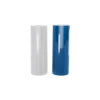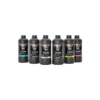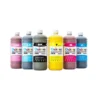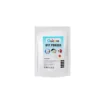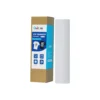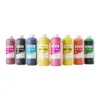What is ink spatter and ink dispersion?
ink spatter and ink dispersion both refer to the movement and spread of ink droplets in ways that deviate from the intended pattern during the printing process. These issues can undermine print quality and lead to a variety of visual defects. Nevertheless, understanding the causes of ink spatter and ink dispersion is the first step toward achieving better results with your UV DTF printer.
Ink Spatter
“ink spatter” occurs when ink droplets are ejected too forcefully from the printhead, or when environmental factors influence their trajectory. This uncontrolled dispersion can result in ink droplets landing outside the designated print area, leading to a lack of precision in the print job. Furthermore, the primary causes of ink spatter are:
- Ink Jetting Mechanism: UV DTF printers use piezoelectric printheads, which rely on electrical pulses to eject tiny ink droplets. If the printhead is miscalibrated, it can eject ink with too much force or produce droplets that are too large, leading to ink spatter.
- Improper Droplet Formation: For a high-quality print, UV DTF printers need to create consistent, small droplets. Issues like incorrect ink viscosity, temperature fluctuations, or excessive pressure can lead to the formation of larger, erratic droplets, causing ink to fly off target.
- Environmental Factors: External elements like airflow, drafts from fans, or fluctuating humidity levels can affect the path of the ink droplets. Inconsistent environmental conditions can lead to uneven dispersion and ink spatter.
- Substrate Interaction: The surface of the substrate being printed on plays a role in ink spatter. Rough or uneven surfaces can create irregular paths for the ink droplets, causing them to scatter. Additionally, overly absorbent substrates may cause ink droplets to sink too quickly, leading to distortion in the print.
- Curing Process: The UV curing process is crucial in solidifying the ink. If the curing lamp is placed too close to the printhead, or if the timing of the curing is off, the ink can start curing prematurely, causing it to fly off before it has properly adhered to the substrate.

Ink Dispersion
Ink dispersion in UV DTF printing occurs when ink droplets spread unevenly or fail to land within the designated area. This results in blurry or uneven images and reduces print clarity. Several factors contribute to ink dispersion:
- Ink Droplet Formation: The piezoelectric printhead is designed to eject ink droplets in a precise, controlled pattern. However, if there are issues with the pressure or viscosity of the ink, the droplets may not form properly and can spread beyond the intended print area.
- Inadequate Droplet Control: Ink dispersion happens when the printhead is unable to control the ink droplets effectively. Factors like improper ink viscosity, excessive heat, or incorrect pressure in the printhead can cause the droplets to spread out or merge, leading to unwanted bleeding and blending of colors.
- Ink Flow Disruption: UV DTF inks need to maintain a specific viscosity to keep droplets uniform. Ink that is too thin or too thick can flow erratically, resulting in uneven droplet formation and ink dispersion. Both overly viscous and overly fluid inks can cause problems.
- Surface Tension and Ink Interaction: Upon hitting the substrate, the interaction between the ink’s surface tension and the material’s surface plays a crucial role in maintaining accuracy. If dispersion occurs, the ink spreads beyond the desired area, often resulting in streaking or a smudged look.
- UV Light Curing: Since UV DTF inks are UV-curable, the curing process is essential for hardening the ink. If ink dispersion has occurred, uneven curing may take place, leading to inconsistent results where some areas may cure properly while others remain tacky or uncured.

Reasons for UV DTF Ink Spatter
There are several common causes of ink spatter in UV DTF printing, which can be divided into issues with the ink, printhead, environmental factors, and equipment:
Ink Problems
- Abnormal Ink Viscosity: Ink that is too thin or too thick can affect the jet stability and cause ink to fly off course.
- Ink Incompatibility: Using inks that are not compatible with the printer’s printhead may lead to irregular jetting and ink spatter.
Printhead Problems
- Clogged or Damaged Printhead: A clogged nozzle can cause the ink to be ejected at an abnormal angle, resulting in flying ink.
- Printhead Aging: Over time, the printhead may degrade, leading to decreased accuracy in ink jetting.
Environmental Problems
- Static Interference: Static electricity can interfere with the trajectory of ink droplets, causing them to fly off course.
- Humidity Issues: A printing environment that is too dry or too humid can affect ink behavior. Causing it to either dry too fast or become too fluid.
Equipment Problems
- Improper Printhead Voltage Setting: Incorrect jet voltage can lead to unstable ink droplets.
- Printing Speed is Too Fast: High printing speeds may result in incomplete ink droplet formation, leading to ink spatter.
How to Solve UV DTF Ink Spatter
To resolve the issue of ink spatter, several steps can be taken:
Check for Ink Problems
- Use Quality Ink: Ensure you’re using the recommended ink with proper viscosity and flow characteristics for the printhead.
- Check Ink Status: Avoid using expired or improperly stored ink, as it can cause inconsistencies in the printing process.
Clean Printheads
- Use Cleaning Fluid: Use the printer’s cleaning function to perform light or deep cleaning of the printhead.
- Manual Printhead Cleaning: For stubborn clogs, soak the printhead in a specialized cleaning solution to remove dried ink.
- Check Nozzle Condition: Run a nozzle inspection to confirm the printhead is in good working condition.
Adjust Equipment Settings
- Optimize Printhead Voltage: Adjust the jet voltage to match the recommended range for the ink type and environmental conditions.
- Reduce Printing Speed: Lower the printing speed to allow for more precise ink drop formation.
Improve Environmental Conditions
- Control Humidity: Maintain a humidity level between 40% and 60% to prevent static interference and avoid ink drying too quickly.
- Anti-Static Measures: Likewise, you can use anti-static mats or an air humidifier to reduce static electricity in the printing environment.
Equipment Maintenance and Inspection
- Check Printhead Installation: Ensure the printheads are securely installed and correctly positioned.
- Check Negative Pressure System: Make sure the ink supply is consistent and there is no issue with the negative pressure system that could lead to ink spatter.
- Clean the Printer Internals: Regularly clean the inside of the printer to prevent ink contamination from previous prints.
Causes of UV DTF Ink Dispersion
- Incorrect Printhead Settings: If the printhead’s pressure or temperature is incorrectly adjusted. It can lead to ink dispersion during the printing process.
- Low-Quality Ink: Ink that is improperly formulated may lack the right balance of viscosity and surface tension. Which can contribute to dispersion.
- Environmental Conditions: Fluctuations in temperature and humidity can affect how the ink behaves, causing it to disperse more than intended.
- Poor Transfer Film Quality: The transfer film’s coating or surface properties may not be compatible with the ink. Leading to adhesion issues and dispersion.
What If the UV DTF Ink Dispersion Occurs?
If ink dispersion is occurring, here are some additional steps to address the issue:
- Check the Print Settings: Ensure that ink volume settings and curve configurations are optimized for the print job.
- Examine the Ink Supply System: Verify that the ink supply pressure is consistent and that the ink bottles are not overfilled, which can disrupt the flow.
- Check Ink Type: Confirm that the ink is suitable for the material being printed on. Different substrates may require different ink formulations.
- Inspect Material: Ensure the substrate is not absorbing ink too quickly due to environmental moisture or other issues that may affect the material’s ability to hold ink properly.

